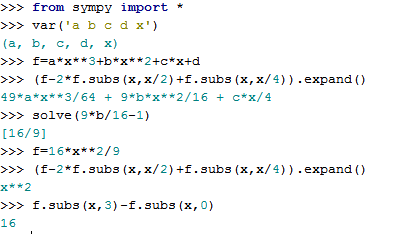An interesting functional equation
Let f : R → R be a continuous function such that
f ( x ) − 2 f ( 2 x ) + f ( 4 x ) = x 2
Find f ( 3 ) − f ( 0 ) .
The answer is 16.
This section requires Javascript.
You are seeing this because something didn't load right. We suggest you, (a) try
refreshing the page, (b) enabling javascript if it is disabled on your browser and,
finally, (c)
loading the
non-javascript version of this page
. We're sorry about the hassle.
5 solutions
Just loved solving it!
Could anybody please tell me how to type infinity in LaTeX.
Log in to reply
\ ( \ infty \ ) Just remove the spaces
Nice solution! I did mine a bit differently by trying to solve the functional equation.
Superb solution!
Yeah did the same.
By hit and error let f(x) be kx²+c so From Given equation get that k=16/9 Hence easily find the required difference.
I kinda assumed that f is a polynomial which seemed reasonable as we have a polynomial on one side and f is continuous. Let one such term of f be a*x^n. If n=2, we want the coefficient of the LHS (which is a polynomial) to be 1 and the rest of the terms to drop out. If you just look at the x^n term, you see that (coefficient) x^n (2^2n -2^n+1 +1)/2^2n=0 whenever n not equal to 2. However, this is zero only when coefficient=0, x=0, or n=0 (constant term). But we want this to always equal to 0: so the coefficent is 0. Thus the only terms present are a quadratic and a constant term. WLOG you can set the constant term to 0 since whatever it is, it cancels out on the LHS. Then you say f=k *x^2, and you can find that k=16/9. Thus f(3)-f(0)=16-0=16.
The problem becomes a lot easier if you assume f is also three-times differentiable. Application of the chain rule shows f'(0) = 0, f''(0) = 32/9, and all higher-order derivatives are identically 0. Therefore, Taylor's Theorem yields f(3) = f(0) + 0 + (32/9) (1/2) (3-0)^2 + 0, which implies f(3) - f(0) = 16
You never know with functional equations, and I'm really wobbly with them. For no good reason, other than the presence of the x 2 on the right, I assumed a cubic polynomial.

- define a cubic with arbitrary coefficients
- rewrite the given functional equation in terms of the cubic, expand and simplify
- compare like terms in the indeterminate
- check that the resulting cubic satisfies the functional equation
- calculate required result
We have:
( f ( x ) − f ( 2 x ) ) − ( f ( 2 x ) − f ( 4 x ) ) = x 2
Replacing x by 2 x :
( f ( 2 x ) − f ( 4 x ) ) − ( f ( 4 x ) − f ( 8 x ) ) = 4 x 2
Now again replace x by 4 x and write the next term. Continuing this process uptil n + 1 terms:
( f ( 2 n x ) − f ( 2 n + 1 x ) ) − ( f ( 2 n + 1 x ) − f ( 2 n + 2 x ) ) = 2 2 n x 2
Now adding everything and taking n → ∞ we obtain:
f ( x ) − f ( 2 x ) = 3 4 x 2
Note that right hand side was obtained by adding infinite terms of a G.P. Further note that as n → ∞ we have:
f ( 2 n + 1 x ) = f ( 2 n + 2 x )
Now we shall again repeat this process. Replacing x by 2 x , 4 x and so on and then adding all the terms we obtain:
f ( x ) − f ( 0 ) = 9 1 6 x 2
Again note that as n → ∞ we have:
f ( 2 n + 1 x ) = f ( 0 )
Now just substitute x = 3 to obtain the answer ! :)
This is my first solution, so please be nice in the comments as a lot of effort has gone into typing it :)